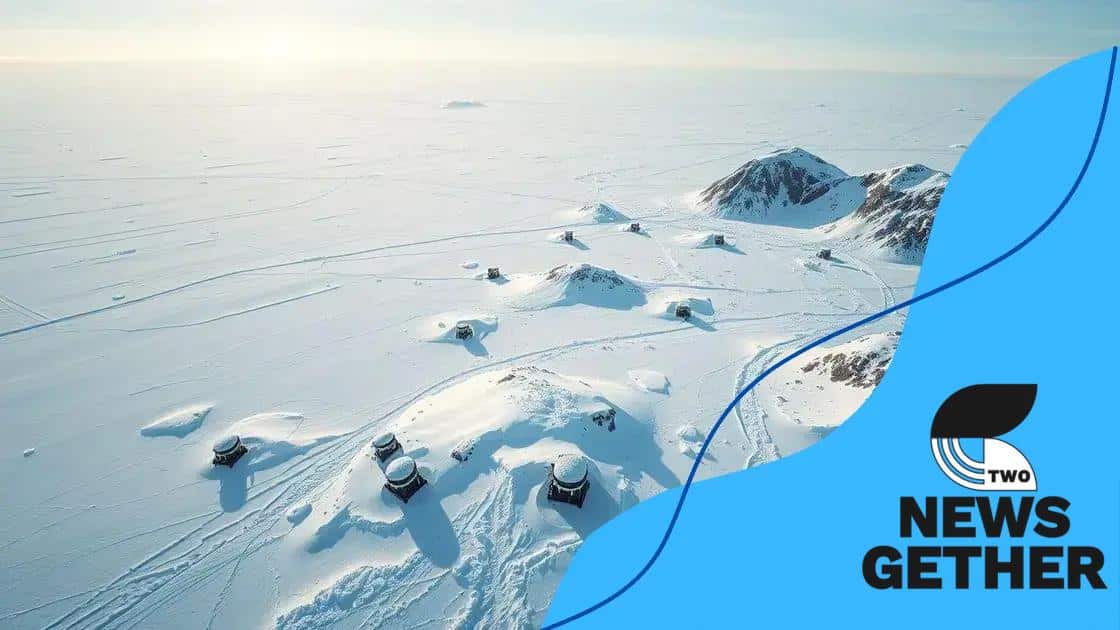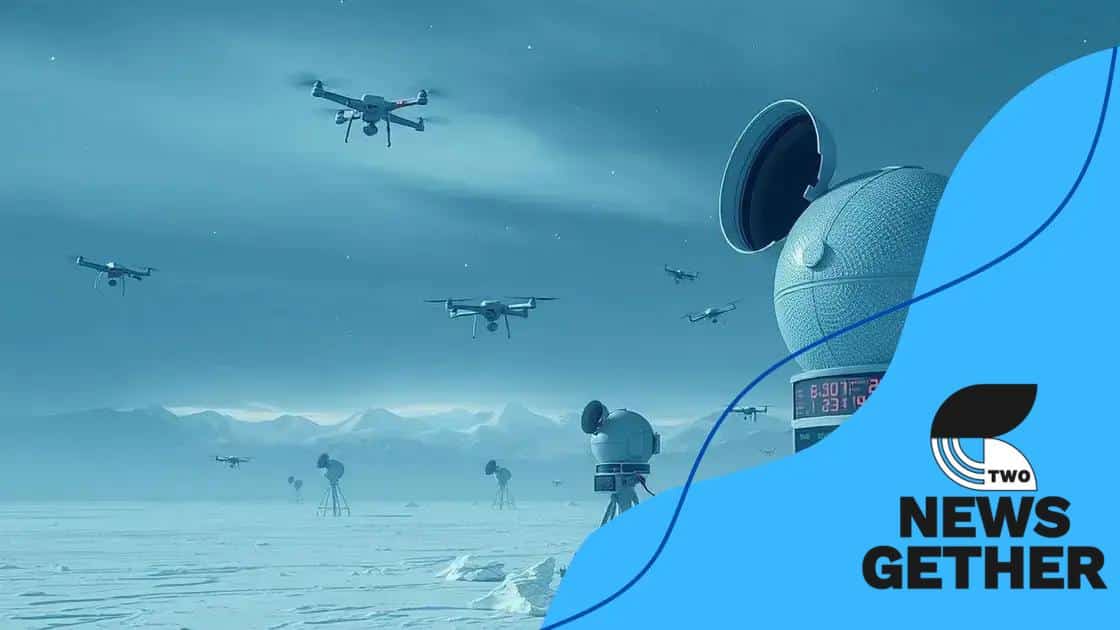US spy agencies Greenland surveillance raises eyebrows

US spy agencies conduct surveillance in Greenland primarily to ensure national security, monitor military activities of adversarial nations, and address geopolitical interests in the rapidly changing Arctic region.
US spy agencies Greenland surveillance has become a topic of growing interest, raising questions about the real purpose behind these operations. Could there be more than meets the eye? Let’s dive into the details.
Background of US surveillance in Greenland
The background of US surveillance in Greenland is rich with history and intrigue. As a strategic location, Greenland has always attracted attention from powerful nations. The remote and vast expanse serves as a vital point for intelligence gathering.
Historical Context
Since World War II, Greenland has been crucial for military operations. The US established bases, which still operate to this day. This military presence is partly due to the island’s location between North America and Europe.
Reasons for Surveillance
The current reasons for monitoring Greenland span various aspects:
- Geopolitical interests in the Arctic region
- Monitoring of military activities from Russia and China
- Natural resource exploration and environmental changes
As global warming melts ice caps, Greenland’s resources are becoming more accessible, prompting further surveillance. The US aims to secure its interests while navigating complex international relations.
Moreover, technology is playing a vital role. Advanced satellites and listening posts allow agencies to gather data effectively. These tools provide detailed insights without requiring a physical presence on the ground.
Understanding this background gives us a clearer picture of why US spy agencies are so focused on Greenland. From historical relationships to current geopolitical strategies, the emphasis on surveillance reflects broader international dynamics.
Key objectives of the surveillance
The key objectives of the surveillance by US agencies in Greenland are multi-faceted and critical in today’s geopolitical climate. These objectives focus on national security, monitoring adversarial actions, and securing economic interests.
National Security
A primary aim is to ensure national security. Greenland’s location makes it essential for monitoring potential threats from other nations. With the Arctic region becoming increasingly strategic, keeping an eye on activities is crucial.
Monitoring Adversarial Actions
Tracking military developments from countries like Russia and China is another central goal. As these nations expand their presence in the Arctic, the need for intelligence gathering grows. This helps the US assess risks and respond effectively.
- Identifying military build-up around strategic locations
- Monitoring naval movements in Arctic waters
- Tracking satellite launches and missile activities
Moreover, understanding these activities can prevent surprise encounters and foster readiness in various scenarios. The surveillance also plays a role in diplomacy; with accurate data, the US can engage thoughtfully with its allies and adversaries alike.
Securing economic interests in Greenland is yet another objective. As natural resources in the Arctic become more accessible, US agencies aim to monitor exploration and extraction activities. This not only safeguards US investments but also ensures that other nations do not dominate resource access.
In summary, the intelligence-gathering efforts in Greenland are driven by a mix of national security concerns, adversarial monitoring, and economic interests. By focusing on these objectives, US spy agencies strive to maintain stability and security in a rapidly changing world.
Technologies used for monitoring

The technologies used for monitoring by US spy agencies in Greenland are advanced and diverse. These technologies help gather vital intelligence in a challenging environment, ensuring national security and international interests are protected.
Satellite Imagery
One of the key tools is satellite imagery. Satellites provide high-resolution images of the region, allowing for detailed observation of military movements and infrastructure development. This enables quick assessments and ongoing monitoring of activities in remote areas.
Radar Systems
Radar systems play a crucial role as well. Ground-based and aerial radar can detect aircraft, ships, and other vehicles. These systems help track unusual movements, providing actionable data to intelligence analysts.
- Monitoring ice conditions for navigation
- Detecting unauthorized fishing or shipping
- Surveillance of military bases
In addition to radar, drones are increasingly used for surveillance. These unmanned aerial vehicles can cover large areas, collecting images and data from various angles. Drones are particularly effective for reaching inaccessible locations, gathering information without risking personnel.
Signal intelligence (SIGINT) is another component. Agencies can intercept communications, including phone and internet traffic. This helps gather insights about potential adversaries, monitoring their activities and plans effectively.
Overall, the combination of **satellite imagery**, radar systems, **drones**, and signal intelligence creates a robust framework for monitoring. These technologies enable US agencies to maintain a strategic advantage while viewing Greenland’s developments from multiple dimensions.
Implications for international relations
The implications for international relations resulting from US surveillance in Greenland are profound and multifaceted. With increasing military activities and geopolitical interests at play, understanding these implications is crucial for global diplomacy.
Heightened Tensions
One major implication is heightened tensions with nations like Russia and China. Both countries have shown interest in the Arctic, and US surveillance can be perceived as a threat. This can lead to increased military posturing and potential conflicts.
Collaborative Opportunities
On the other hand, US monitoring efforts can create opportunities for collaboration. Countries sharing similar interests in Arctic governance may find common ground in addressing issues like climate change and protecting shipping routes. Collaborative efforts can be beneficial when addressing shared challenges.
- Joint military exercises with allies
- Cooperation on environmental monitoring
- Information sharing regarding resource management
Moreover, transparency in these surveillance activities can build trust among nations. Clear communication about intentions helps reduce misunderstandings, fostering a more stable international environment.
The Arctic Council, which includes various countries, plays a significant role in managing these relationships. The US can engage with other Arctic states to discuss surveillance implications while promoting shared interests like safety and sustainable development.
Overall, the relationship between US surveillance in Greenland and international relations showcases a delicate balance. While it can create tension, it also offers pathways toward collaboration and dialogue. Emphasizing diplomacy during discussions can contribute positively to the global landscape.
Public reaction to surveillance activities
The public reaction to surveillance activities conducted by US spy agencies in Greenland varies widely and is shaped by different perspectives. Many citizens express concern over privacy, while others support these efforts due to security needs.
Concerns About Privacy
One significant reaction comes from privacy advocates. They argue that increased surveillance infringes on personal freedoms. People worry that their data might be collected without consent and that government overreach could become a norm.
Support for National Security
On the other hand, many citizens understand the importance of surveillance for national security. With rising global tensions, they see monitoring as necessary to protect the country from potential threats. This group believes that security efforts justify some level of surveillance activities.
- Increased threat perception from rival nations
- Desire to safeguard national resources
- Support for proactive defense measures
Social media plays a significant role in shaping public opinion. Online discussions reveal a range of views, from outright opposition to enthusiastic support. Some activists organize campaigns to raise awareness about privacy rights.
Additionally, local communities in Greenland often engage in conversations about the surveillance presence. They express concerns about how it impacts their daily lives, especially regarding environmental monitoring and cultural preservation.
Media coverage also influences perceptions. Reports highlighting the importance of security can sway public opinion toward supporting surveillance, while stories that focus on privacy violations can fuel distrust and fear.
Overall, the reaction to surveillance activities in Greenland reflects a complex mix of concern for civil liberties and support for safety. Understanding these diverse viewpoints is essential in navigating the ongoing discussion about surveillance in modern society.
Future of intelligence efforts in Greenland

The future of intelligence efforts in Greenland looks poised for significant evolution as global dynamics shift. With increasing interest in the Arctic, agencies are adapting their strategies to meet new challenges.
Strategic Enhancements
US intelligence agencies are likely to enhance their surveillance capabilities. This may include upgrading technology and expanding operational areas. Investments in advanced satellites and drones can provide even more precise data.
Collaboration with Allies
Another key trend involves collaboration with international partners. As countries work together to address shared concerns, joint intelligence programs could emerge. Such cooperation can improve effectiveness and foster trust between nations.
- Sharing resources for better data collection
- Coordinating responses to mutual threats
- Engaging in joint Arctic research initiatives
As global warming continues to impact the Arctic region, environmental intelligence will become increasingly important. Monitoring changes in ice patterns and wildlife will help address environmental challenges while ensuring national security remains a priority.
Furthermore, public opinion will influence intelligence activities. As citizens become more aware and involved, agencies may adopt more transparent practices. Engaging with local communities can provide insights that improve surveillance efforts while respecting residents’ concerns.
Ultimately, the future landscape of intelligence efforts in Greenland is likely to be shaped by technological advancements, cooperative international relations, environmental considerations, and evolving public perceptions. Staying adaptable will be crucial for agencies aiming to maintain security and address the needs of the changing Arctic.
FAQ – Frequently Asked Questions about US Surveillance in Greenland
What is the purpose of US surveillance in Greenland?
The primary purpose is to ensure national security by monitoring military activities and geopolitical developments in the Arctic region.
How does surveillance impact international relations?
Surveillance can heighten tensions with rival nations but also create opportunities for collaboration on shared interests like environmental protection.
What technologies are used for surveillance in Greenland?
Technologies include satellites for imagery, radar systems for tracking movements, and drones for collecting data from remote areas.
What are the public’s concerns regarding surveillance?
Many people express concerns over privacy and potential government overreach, while others support surveillance for improved national security.






